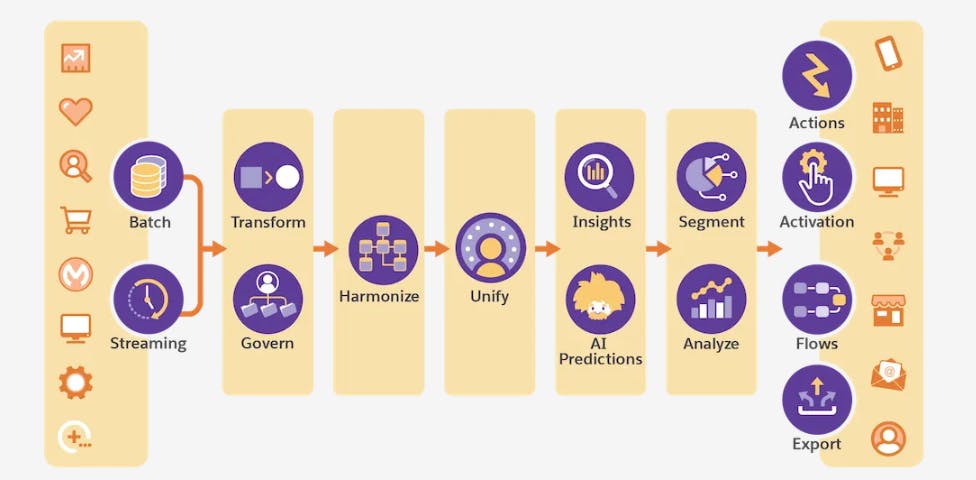Get Started With Data Cloud
What is Data Cloud
Data Cloud is a platform that helps businesses make their customers happy in real-time. It does this by bringing together all the information about customers and using AI and automation to take smart actions. This can boost your revenue while saving time and money.
Here's how it works:
Connect: It connects all your customer data from various sources, like apps and devices, in real time. It has ready-to-use connections for this.
Harmonize: This means it organizes all that data into a single customer picture. Think of it like putting together a puzzle.
Engage: It helps all parts of your company, no matter what they do, by providing them with a clear and up-to-date view of your customers.
Experience: It helps you create amazing experiences for your customers exactly when they need it, like when every second counts.

Data Cloud connects to various Salesforce and external data sources, including:
Sales, Service, Commerce, and Marketing Cloud connectors
Amazon S3, Google storage connectors
Ingestion API and Salesforce Interaction SDK
Web and Mobile connectors
MuleSoft connector and many more
Transform: Data Cloud allows customers to prepare, cleanse, and transform data before it is used.
Govern: Data spaces that allow you to logically partition the data you can have different business units working on different versions of partition of that data.
Harmonize: Now the data is transformed and cleansed we still have a problem the schemas are very different across your enterprise (can be called contact, person ) with data cloud you can now harmonize all these different schema points what we call as canonical model and use this model to map your schema in customer 360 and you can also package the data and share it with other org.
Unify: Once the data is harmonized you can now unify all that data using identity solutions.
Unify: Collecting Customer Data: Imagine you have lots of information about your customers, like their names, emails, and what they buy from your store. You store all of this data in one place, which we'll call the "Data Cloud."
Creating Customer Profiles: Now, you can take all the data from different sources and put it together to make a complete profile for each customer. This profile includes everything you know about them.
Insights: Insights create metrics such as “total customer value” or “products over $500.” Streaming insights are created based on a rolling time window. For example, you can identify the click-through rate of all the products in an online storefront in the past 30 minutes.
Making Data Smarter: [AI Prediction] You can use special computer programs and AI to make the data even more useful. For example, you can figure out which customers are more likely to buy certain products in the future.[ amazon sagemaker]
Sorting Customers [Segments]: You can group customers together based on certain characteristics. For instance, you can put all the customers who like sports in one group and those who prefer movies in another. These groups are called "segments."
Seeing the Big Picture [Analyse]: Finally, you can use tools like Tableau to look at all this data in a way that's easy to understand. It helps you see trends and make decisions about your business.
So, in a nutshell, it's about collecting, organizing, improving, and analyzing customer data to help your business make better choices.
Act on Data: Now you can use your data for marketing like you can have triggered moments to send. like on a birthday you have to send an offer to the buyer.
Why Data Cloud
Technology is advancing quickly, and people now expect to interact with data in real time.
Unified Data Saves Time
AI Reduces Costs
Automation Increases Productivity
With Data Cloud You Can
Combine customer information from different sources to create complete profiles.
Make more targeted groups of customers using insights.
Use and activate data from any part of your organization.
Easily gather and organize lots of data with a high-scale data ingestion service.
Analyze data using tools like Tableau or Marketing Cloud Intelligence.
Look and Feel

Data Streams, Data Lake Objects, and Data Model tabs \=> focused on data ingestion and modeling.
Data Explorer and Profile Explorer \=> data-viewing tools, allowing a view into ingested data and unified profiles.
The Identity Resolutions tab \=> team creates match and reconciliation rules to unify individual records.
Calculated Insights \=> predefined and calculated metrics that can be used in creating segments and for data analysis.
The Setup gear \=> where the admin configures Data Cloud features.
Editions
Data Cloud is available in Lightning Experience for these standard Salesforce editions.
Developer
Enterprise
Performance
Unlimited
| Ad Audiences | Create segments in Data Cloud that you can activate to advertising platforms like Meta. |
| Data Spaces | Organize your data by adding multiple data spaces to your account. |
| Segmentation and Activation | Create segments and batch activations in Data Cloud. |
Multi-Brand Management in Data Cloud


When using Data Cloud, think about how your Marketing Cloud is set up. If your company handles different brands that keep their data separate and have access limitations, you might need separate Data Cloud setups for each brand to maintain.